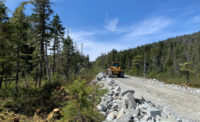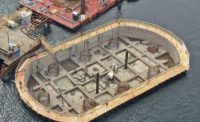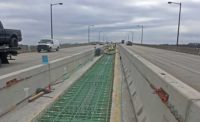Glenn Highway Phase 1 & 2
Eagle Creek, Alaska
PROJECT OF THE YEAR FINALIST and BEST PROJECT
CONTRACTOR: Kiewit Infrastructure West Co.
OWNER: Alaska Dept. of Transportation & Public Facilities (ADOT&PF)
LEAD DESIGN FIRM: Hanson Alaska Professional Services Inc.
SUBCONTRACTORS: Pruhs Construction; North Star Equipment Services; ACME Fence Co.; Eklutna Sand and Gravel; JD Steel; Finishing Edge
When reconstructing a three-mile segment of Glenn Highway in Eagle Creek, Alaska, engineers had to consider two types of travelers: human drivers and spawning fish.
To that end, the team built two four-span bridges over the Eagle River and an earth retaining wall while replacing the 50-year-old culverts to ease fish passage. The project required 436,000 cu yd of earthwork, 50,000 tons of asphalt paving and 250,000 tons of additional material.

Photo courtesy Kiewit Infrastructure West Co.
The four-span bridges were founded on large-diameter drilled shafts over the river using a trestle, with a 583-ft northbound bridge and a 600-ft southbound bridge. The phased construction allowed the team to maintain two lanes of traffic in each direction and accommodate more than 55,000 daily commuters.
During the proposal phase, the team worked closely with the local utility company to develop a design that eliminated 4,000 ft of gas line relocation, saving the project significant costs and allowing the new third lane to be opened to traffic a year early.

Photo courtesy Kiewit Infrastructure West Co.
The team made wetlands mitigation a top priority. The Eagle River teems with fish, and the existing culverts were perched, undersized and considered inadequate for fish passage by the Alaska Dept. of Fish & Game. Kiewit installed oversize culverts and regraded the stream bed to match the natural stream profile. The Eagle River crossing was the first mitigation project approved by the U.S. Army Corps of Engineers in Alaska under 2008 regulations.

Photo courtesy Kiewit Infrastructure West Co.
The project also included a 52,250-sq-ft mechanically stabilized earth (MSE) retaining wall. The panel-setting crew and wall backfill crews worked closely to meet plumb and tolerance requirements, operating to save time and optimize the summer weather. It was critical to finish the south section of the wall (also the north bridge abutment) to keep the bridge work on schedule. The wall design, integrated during Phase 2, minimizes the slope leading into the Eagle River and reduces impacts to the floodplain. The final result of this six-year project is a safer and improved environment at the Eagle River crossing for both vehicles and fish.





Post a comment to this article
Report Abusive Comment